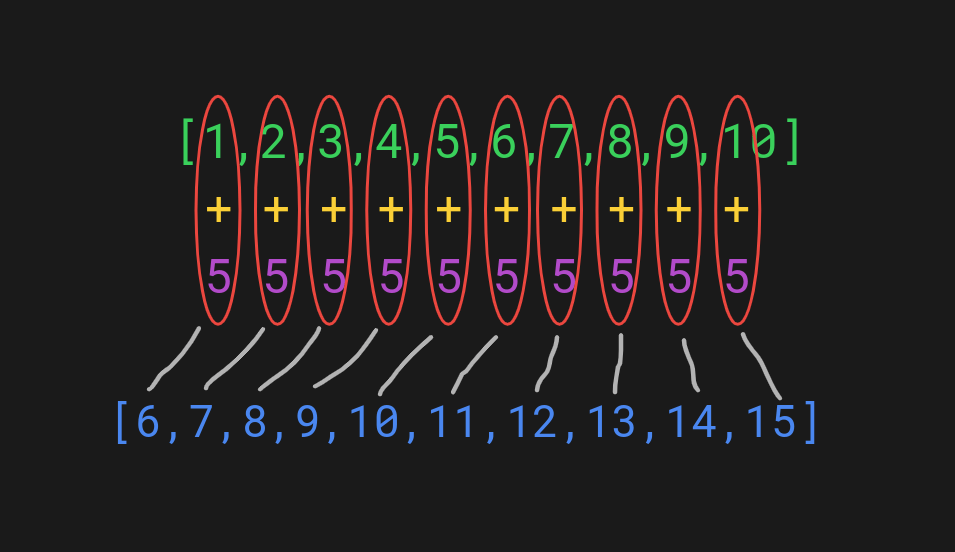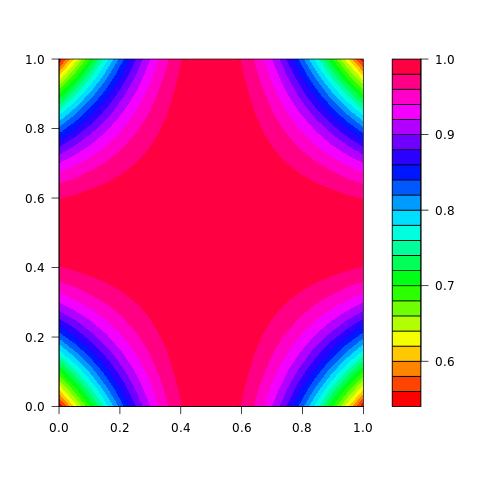In R, the outer() function runs a function on two vectors, creating a result matrix. The generic syntax for using the outer() function is as follows:
outer(x, y, FUN=function(a, b) { statements })
Where x and y are vectors (or scalars) and the FUN is a function that is called on each combination of the elements in the two input vectors.
This is a comprehensive guide to using the outer() function in R. You will learn the usage of the outer() function through common example use cases with detailed explanations and theory.
What Is the outer() Function in R?
Dealing with arrays is commonplace when writing R programs and doing data science. Having the ability to perform an operation between the array elements is a frequent necessity for data scientists.
In R, there’s a built-in outer() function you can call on two vectors (and scalars) to perform an operation between the element combinations of the vectors to create a result matrix.
Here’s the syntax for calling the outer() function:
outer(x, y, FUN=function(a, b) { statements })
Where:
- x is a vector or array (or a scalar)
- y is another vector or array (or a scalar)
- FUN is a function you perform on the elements of the input vectors. The function runs on each element combination between the vectors x and y. The function must take two arguments and return a value.
The function FUN can also use symbols, such as “+” or “*” besides being a separately defined function.
For instance, let’s use the outer() function to add a number to each element of a vector:
x <- 1:10 y <- 5 output1 <- outer(x, y, "+") output1
Output:
[,1] [1,] 6 [2,] 7 [3,] 8 [4,] 9 [5,] 10 [6,] 11 [7,] 12 [8,] 13 [9,] 14 [10,] 15
Now that you have a basic understanding of how the outer() function works, let’s take a look at some common use cases of it. The following examples include calling the outer() function on vectors, creating custom functions, as well as using non-numeric data types.
1. Call outer() Function on Vectors and Scalars
As a first example, let’s call the outer() function on a vector and a scalar. More specifically, let’s create a vector in which you add 5 to each element.
Here’s what the code looks like:
x <- 1:10 y <- 5 output1 <- outer(x, y, "+") output1
Output:
[,1] [1,] 6 [2,] 7 [3,] 8 [4,] 9 [5,] 10 [6,] 11 [7,] 12 [8,] 13 [9,] 14 [10,] 15
Here’s an illustration of how the outer() function operates between the scalar 5 and the vector 1:10:

As stated earlier, the function FUN in the outer() function call takes each combination of the input argument vectors and performs the function on them.
Because in the above example, the input was a vector and a scalar, the addition operation took place for each element in the vector producing a new vector.
2. Call outer() Function on Two Vectors
Now, let’s continue with a very similar example to the first one but instead of a vector and a scalar, let’s operate on two vectors.
Let’s create a matrix of element-wise sums for two vectors from 1 to 10.
Here’s how it looks in the code:
x <- 1:10 y <- 1:10 result <- outer(x, y, "+") result
Output:
[,1] [,2] [,3] [,4] [,5] [,6] [,7] [,8] [,9] [,10] [1,] 2 3 4 5 6 7 8 9 10 11 [2,] 3 4 5 6 7 8 9 10 11 12 [3,] 4 5 6 7 8 9 10 11 12 13 [4,] 5 6 7 8 9 10 11 12 13 14 [5,] 6 7 8 9 10 11 12 13 14 15 [6,] 7 8 9 10 11 12 13 14 15 16 [7,] 8 9 10 11 12 13 14 15 16 17 [8,] 9 10 11 12 13 14 15 16 17 18 [9,] 10 11 12 13 14 15 16 17 18 19 [10,] 11 12 13 14 15 16 17 18 19 20
Now, I’m not going to draw an illustration of this function because the result would be a mess. But the above code works like the first example. Now, the function just takes each element in the vector y and sums it up with each element in the vector x, forming a 10×10 matrix of element-wise sums.
3. Custom Function Argument
Thus far, you’ve only seen the outer() function with an input function of “+”. But this function can be anything else, as long as it takes two elements as arguments and returns a result.
Example 1
For example, let’s create a custom function powerize that raises input argument a to the bth power. Then, let’s call the powerize function for each element pair between two vectors x and y:
x <- 1:3
y <- 1:5
powerize <- function(a, b) {
a^b
}
result <- outer(x, y, powerize)
result
Output:
[,1] [,2] [,3] [,4] [,5] [1,] 1 1 1 1 1 [2,] 2 4 8 16 32 [3,] 3 9 27 81 243
Example 2
As another example, let’s create a colorful plot by creating a grid of values cos(a*b), where a and b are values of uniformly distributed vectors between values -1 and 1.
x <- y <- seq(-1, 1, len=20);
grid <- outer(x, y, function(a, b) { cos(a * b) });
filled.contour(grid, color.palette=rainbow);
Output:


4. Using outer() For Different Data Types
Thus far, you’ve seen examples of calling the outer() function on numbers. But it’s good to realize you’re not only restricted to using numbers with the outer() function. You can perform operations on other data types, such as lists of letters.
For example, let’s create a table of letter combinations given two groups of letters:
x <- LETTERS[1:8] y <- letters[1:5] result <- outer(x, y, "paste") result
Output:
[,1] [,2] [,3] [,4] [,5] [1,] "A a" "A b" "A c" "A d" "A e" [2,] "B a" "B b" "B c" "B d" "B e" [3,] "C a" "C b" "C c" "C d" "C e" [4,] "D a" "D b" "D c" "D d" "D e" [5,] "E a" "E b" "E c" "E d" "E e" [6,] "F a" "F b" "F c" "F d" "F e" [7,] "G a" "G b" "G c" "G d" "G e" [8,] "H a" "H b" "H c" "H d" "H e"
Here the outer() function takes the two sequential lists of letters and creates a table of combinations of the letters in the vectors.
Make sure to also read my guide to the seq() function in R.
Summary
Today you learned how to use the built-in outer() function in R.
To take home, the outer() function performs an operation between two vectors by running a function on all combinations of vector elements. The outer() function takes three arguments x, y, and FUN, where:
- x is the first input vector.
- y is the second input vector.
- FUN is a function that performs an operation for each combination of element pairs from x and y vectors.
Thanks for reading. Happy coding!